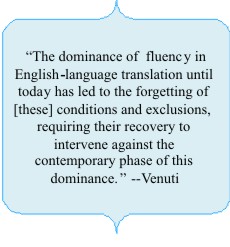| |
Fluency
Venuti observes that fluency as a pre-requisite for good translation is closely linked to prevalent socio-cultural factors: “Fluency emerges in English-language translation during the early modern period, a feature of aristocratic literary culture in seventeenth-century England, and over the next two hundred years it is valued for diverse reasons, cultural and social, in accordance with the vicissitudes of the hegemonic classes” (43). The emphasis on fluency is not seen as a coincidence but a strategy that was consciously or unconsciously meant to preserve the status quo as far as culture and social mores were concerned. Translation practices were based on the values that were cherished by the aristocratic elites which constituted the dominant class of the day. The social system underwent changes after that, but the concept of fluency dominates translation practices even to this day. An understanding of the socio-cultural milieu of those days is necessary to understand how this concept evolved and flourished. It meant that foreign texts that were translated into English catered to English speaking readers, glossing over the fact that the source text was culturally and linguistically different. This enforced homogeneity became a mask for differences of any sort, encouraging readers to expect differences to assimilate themselves to the main language. the hegemonic classes” (43). The emphasis on fluency is not seen as a coincidence but a strategy that was consciously or unconsciously meant to preserve the status quo as far as culture and social mores were concerned. Translation practices were based on the values that were cherished by the aristocratic elites which constituted the dominant class of the day. The social system underwent changes after that, but the concept of fluency dominates translation practices even to this day. An understanding of the socio-cultural milieu of those days is necessary to understand how this concept evolved and flourished. It meant that foreign texts that were translated into English catered to English speaking readers, glossing over the fact that the source text was culturally and linguistically different. This enforced homogeneity became a mask for differences of any sort, encouraging readers to expect differences to assimilate themselves to the main language.
|